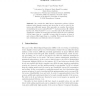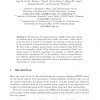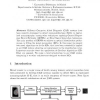ICA
2004
Springer
15 years 6 months ago
2004
Springer
We consider the Blind Source Separation problem of linear mixtures with singular matrices and show that it can be solved if the sources are sufficiently sparse. More generally, we ...
103
click to vote
ICA
2004
Springer
15 years 6 months ago
2004
Springer
We discuss a 3D spatial analysis of fMRI data taken during a combined word perception and motor task. The event - based experiment was part of a study to investigate the network of...
91
Voted
ICA
2004
Springer
15 years 6 months ago
2004
Springer
The blind separation problem where the sources are not independent, but have variance-dependencies is discussed. Hyv¨arinen and Hurri[1] proposed an algorithm which requires no as...
111
click to vote
ICA
2004
Springer
15 years 6 months ago
2004
Springer
Abstract. We present a straightforward way to use temporal decorrelation as preprocessing in linear and post-nonlinear independent component analysis (ICA) with higher order statis...
ICA
2004
Springer
15 years 6 months ago
2004
Springer
The analysis and characterization of atrial tachyarrhythmias requires the previous estimation of the atrial activity (AA) free from any ventricular activity and other artefacts. Th...
103
click to vote
ICA
2004
Springer
15 years 6 months ago
2004
Springer
The paper deals with blind source separation of images. The model which is adopted here is a convolutive multi-dimensional one. Recent results about polynomial matrices in several ...
101
Voted
ICA
2004
Springer
15 years 6 months ago
2004
Springer
This paper addresses the blind separation of noisy mixtures of independent sources. It discusses issues and techniques related to computing maximum likelihood estimates in Gaussian...
111
click to vote
ICA
2004
Springer
15 years 6 months ago
2004
Springer
We address the blind source separation (BSS) problem for the convolutive mixing case. Second-order statistical methods are employed assuming the source signals are non-stationary a...
ICA
2004
Springer
15 years 6 months ago
2004
Springer
Different Computer Aided Diagnosis (CAD) systems have been recently developed to detect microcalcifications (MCs) in digitalized mammography, among other techniques, applying Gen...
75
Voted
ICA
2004
Springer
15 years 6 months ago
2004
Springer
We propose a relative optimization framework for quasi maximum likelihood blind deconvolution and the relative Newton method as its particular instance. Special Hessian structure a...






